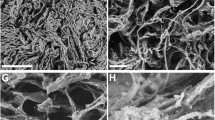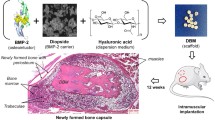Abstract.
The cellular and biochemical sequences of osteogenesis induced by implanting demineralized bone matrix (DBM) in rat cranial defects and in subcutaneous sites have been studied by histological, histochemical, and biochemical techniques from days 2 to 28 after implantation. In subcutaneous sites, allogenic DBM induced cartilage cells and matrix for approximately the first 10 days which were subsequently resorbed and replaced by bone with little evidence for the classical endochondral sequence of ossification. In sharp contrast, the first cells that differentiated from the mesenchymal stem cells in the cranial defects were alkaline phosphatase (ALP) positively stained osteoblasts that appeared 3 days after implantation followed by synthesis of bone matrix which calcified shortly thereafter. A few clusters of cartilage cells were observed beginning at days 6–7 which were spatially distinct from the new bone and later resorbed. By day 28 the tissue induced in both the subcutaneous and cranial sites consisted almost solely of bone; however, the total amount of new bone in the subcutaneous implants was significantly less than the mass of bone formed in the calvarial defects. Bovine DBM induced bone formation in rat cranial defects to a very much lesser extent than allogenic DBM. A few cartilage cells were induced by bovine DBM in subcutaneous sites and rapidly resorbed and not replaced with bone. These results clearly indicate that the cellular sequence induced by allogenic and xenogenic DBM and the repair tissues synthesized are distinctly different in the cranial defects from those induced in the subcutaneous sites.
Similar content being viewed by others
Author information
Authors and Affiliations
Additional information
Received: 1 September 1998 / Accepted: 15 January 1999
Rights and permissions
About this article
Cite this article
Wang, J., Glimcher, M. Characterization of Matrix-Induced Osteogenesis in Rat Calvarial Bone Defects: I. Differences in the Cellular Response to Demineralized Bone Matrix Implanted in Calvarial Defects and in Subcutaneous Sites. Calcif Tissue Int 65, 156–165 (1999). https://doi.org/10.1007/s002239900676
Issue Date:
DOI: https://doi.org/10.1007/s002239900676




